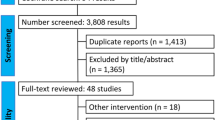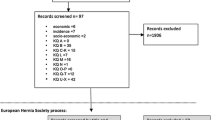Abstract
Purpose
We aimed to study trends over time in operation rates for inguinal hernia with and without obstruction over five decades.
Methods
Routine hospital statistics were used to analyse trends in National Health Service hospitals in England (1968–2011).
Results
All-England admission rates for elective repair of unobstructed inguinal hernia in males were 240.8 episodes per 100,000 population [95 % confidence interval (CI) 234.5–247.2] in 1968 and were relatively stable until 2003 after which they declined to 217.1 (215.4–218.8) by 2011. However, the stability of the all ages rates masked a large decline in admission rates in the young (e.g. 425 per 100,000 in 1968–1970 in males under 1 year of age, down to 155 per 100,000 in 2007–2011) and a large increase in the elderly (e.g. 247 in 1968–1970 per 100,000 males aged 75–84, up to 799 per 100,000 in 2007–2011). All-England admission rates for obstructed inguinal hernia in males almost halved, from 19.3 episodes (17.4–21.2) in 1968 to 10.7 episodes (10.3–11.0) per 100,000 population in 2011. Admission rates for females gradually declined over time for both unobstructed and obstructed inguinal hernia.
Conclusion
Hospital admission rates for elective operation on inguinal hernia without obstruction, for all ages combined, have been relatively stable over five decades, but this masked big differences between age groups. Rates of obstructed hernia have declined over time, particularly in the early years covered by the study, and have not shown an increase associated with the recent fall in elective surgery for hernia repair.


Similar content being viewed by others
References
Kingsnorth A, LeBlanc K (2003) Hernias: inguinal and incisional. Lancet 362:1561–1571
National Institute of Clinical Excellence (NICE) (2004) Technology appraisal guidance 83: Laparoscopic surgery for inguinal hernia repair. NICE, London. http://www.nice.org.uk/nicemedia/live/11542/32924/32924.pdf. Accessed 4 Oct 2013
Primatesta P, Goldacre MJ (1996) Inguinal hernia repair: incidence of elective and emergency surgery, readmission and mortality. Int J Epidemiol 25:835–894
O’Rourke MG, O’Rourke TR (2012) Inguinal hernia: aetiology, diagnosis, post-repair pain and compensation. ANZ J Surg 82(4):201–206. doi:10.1111/j.1445-2197.2011.05755.x (Epub 2011 Apr 25. Review. PMID:22510174)
Powell TG, Hallows JA, Cooke RWI, Pharoah POD (1986) Why do so many small infants develop an inguinal hernia? Arch Dis Child 61:991–995
Wilkinson AW, Arneil TA (1978) Surgical aspects of paediatrics. In: Forfar JO, Gavin AC (eds) Textbook of paediatrics, 2nd edn. Churchill Livingstone, New York, p 1588
Wang KS (2012) Committee on fetus and newborn and section on surgery. Assessment and management of inguinal hernia in infants. Pediatrics 130:768–773
Thames Valley Priorities Committees (Oxfordshire PCTs) (2006) Policy statement 68a: elective surgery for the treatment of inguinal hernia in adults, Ref TV51. http://www.oxfordshireccg.nhs.uk/wp-content/uploads/2013/03/PS68-Inguinal-hernia-surgery.pdf. Accessed 9 Sept 2014
Simons MP, Aufenacker T, Bay-Nielsen M et al (2009) European Hernia Society guidelines on the treatment of inguinal hernia in adult patients. Hernia 4:343–403
Burcharth J, Pedersen M, Bisgaard T, Pedersen C, Rosenberg J (2013) Nationwide prevalence of groin hernia repair. PLoS One 8:1–6
Hernandez-Irizarry R, Zendejas B, Ramirez T et al (2012) Trends in emergent inguinal hernia surgery in Olmsted County, MN: a population-based study. Hernia 16:397–403
Fitzgibbons Rj G-HAGJO et al (2006) Watchful waiting vs repair of inguinal hernia in minimally symptomatic men: a randomized clinical trial. JAMA 295:285–292
Hawe K (2009) Private Health Care. In: Hawe E (ed) Office of Health Economics Compendium of Health Statistics. Radcliffe Publishing Ltd, Abingdon, pp 125–132
Acknowledgments
The Unit of Health-Care Epidemiology was funded by the English National Institute for Health Research to build the datasets (grant number RNC/035/02). MJG is part-funded by Public Health England. The views expressed in this paper do not necessarily reflect those of the funding bodies.
Conflict of interest
The authors declare no conflicts of interest. This was an independent study; the funding source had no involvement in the study design, data collection, data analysis and interpretation, writing of the report, or the decision to submit the article for publication. The views expressed are not necessarily those of the funding body.
Ethical Standards
Ethical approval for a multi-purpose programme of work analyzing these anonymised datasets was obtained from the UK National Research Ethics Service (04/Q2006/176).
Author information
Authors and Affiliations
Corresponding author
Electronic supplementary material
Below is the link to the electronic supplementary material.
Rights and permissions
About this article
Cite this article
Maisonneuve, J.J., Yeates, D. & Goldacre, M.J. Trends in operation rates for inguinal hernia over five decades in England: database study. Hernia 19, 713–718 (2015). https://doi.org/10.1007/s10029-014-1314-9
Received:
Accepted:
Published:
Issue Date:
DOI: https://doi.org/10.1007/s10029-014-1314-9




